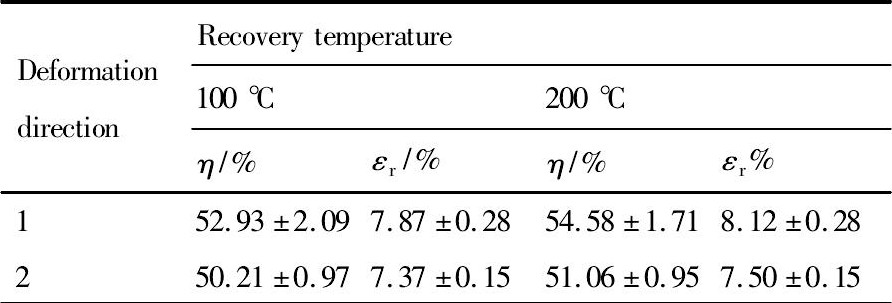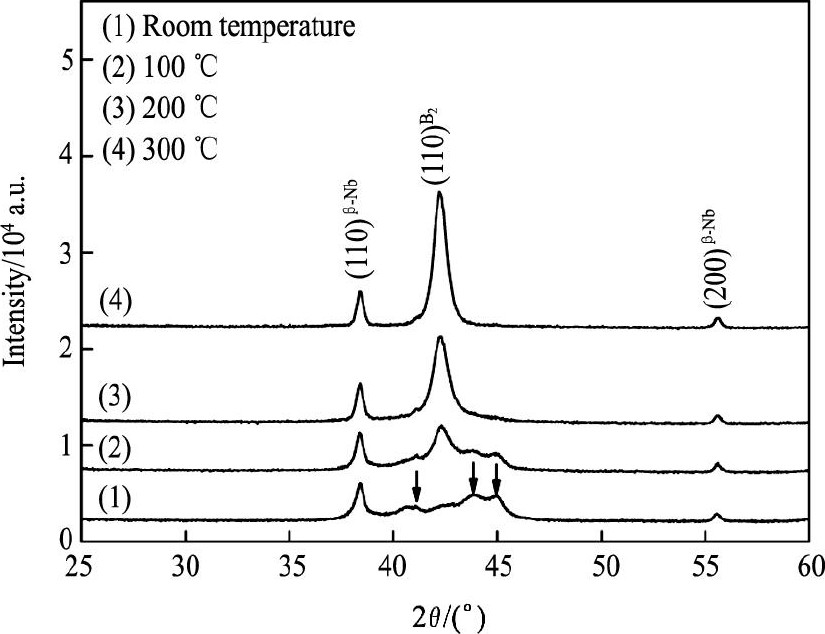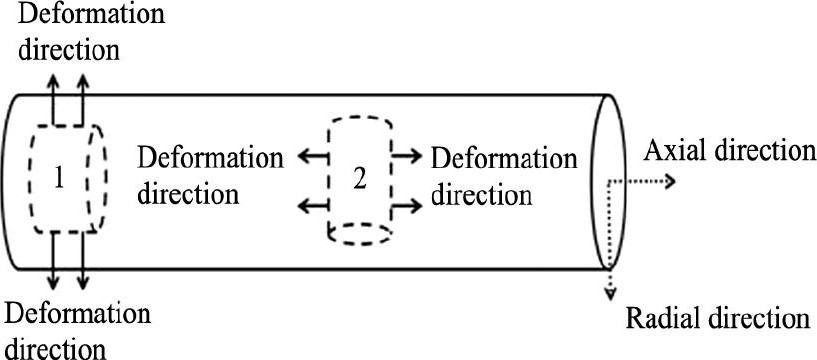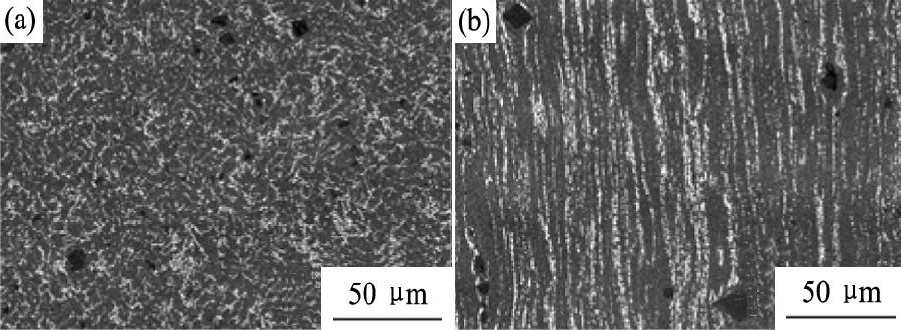网络首发时间: 2017-11-24 17:31
Ni47Ti44Nb9合金锻棒的织构及其对形状记忆性能的影响
中国工程物理研究院机械制造工艺研究所
摘 要:
研究了Ni47Ti44Nb9合金锻棒的组织、织构、形状恢复率和可恢复应变, 分析了锻造织构的形成机制以及对形状记忆性能的影响。采用扫描电子显微镜 (SEM) 观察了微观组织, 采用X射线衍射 (XRD) 和背散射电子衍射 (EBSD) 分析了织构, 采用小管扩径恢复法获得了形状恢复率和可恢复应变。研究结果表明, Ni47Ti44Nb9合金锻棒中的Ni Ti基体相沿轴向呈纤维状分布, 纤维组织之间为β-Nb相, 说明Ni47Ti44Nb9合金经过锻造变形后, Ni Ti相和β-Nb相都产生了较大的塑性变形。Ni47Ti44Nb9合金在锻造过程中主要形成了{111}<110>织构, 即锻棒的轴向∥<111>方向、径向∥<110>方向。其形成机理可归结为Ni47Ti44Nb9合金在锻造过程中受到径向压应力的作用, 使滑移面不断向垂直压应力轴方向转动, 而滑移方向逐渐趋向于流变方向。Ni47Ti44Nb9合金在锻造过程中形成的{111}<110>织构使得在不同方向上进行扩径时获得的记忆性能存在差异, 且当扩径方向∥<110>方向时比扩径方向∥<111>方向时获得的形状恢复率高3.52%, 可恢复应变高0.62%。
关键词:
形状记忆性能;NiTiNb合金;锻棒;织构;形状恢复率;可恢复应变;
中图分类号: TG139.6;TG319
作者简介:孙明艳 (1988-) , 女, 四川绵阳人, 硕士, 工程师, 研究方向:金属功能材料;E-mail:yanmingsun18@caep.cn;;*黄姝珂, 研究员;电话:0816-2485628;E-mail:huangshuke@caep.cn;
收稿日期:2017-07-03
基金:四川省科技厅应用基础研究项目 (2017JY0319);中国工程物理研究院科学技术发展基金项目 (2015B0302060) 资助;
Texture and Its Effect on Shape Memory Properties of Ni47Ti44Nb9 Forged Rods
Sun Mingyan Meng Yutang Zhang Yonghao Wang Yingying Fan Qichao Huang Shuke
Institute of Machinery Manufacturing Technology, China Academy of Engineering Physics
Abstract:
The microstructure, texture, recovery rate and recovery strain of the Ni47Ti44Nb9 forged rods were studied.The formation mechanism of texture and its effect on shape memory properties were also discussed.Microstructure were observed through scanning electronic microscope (SEM) , texture were analyzed by X-ray diffraction (XRD) and electron backscatter diffraction (EBSD) , recovery rate and recovery strain were tested by tube-expansion-recovery method.The results showed that Ni Ti matrix phase in the Ni47Ti44Nb9 forged rods distributed as fibers along the axial direction, whileβ-Nb phase existed between the fibrous microstructures, which indicated that both Ni Ti andβ-Nb phases had large plastic deformation after forging of Ni47Ti44Nb9 alloy.The{111}<110>texture was mainly formed during the forging process of Ni47Ti44Nb9 alloy, that was, the axial direction of forging rod was parallel to the<111>direction while the radial direction was parallel to<110>direction.The formation mechanism could be attributed to the fact that during the forging process, Ni47Ti44Nb9 alloy was subjected to radial compressive stress, so that the slip surface continuously rotated to the direction perpendicular to compressive stress axis and the slip direction tended to the rheological direction gradually.In addition, {111}<110>texture formed in the forging process of Ni47Ti44Nb9 alloy could cause differences in shape memory properties when expanded in different directions.When the expanding direction paralleled to<110>direction, the recovery rate and recovery strain would be 3.52%and 0.62%higher than the case of paralleling to<111>direction respectively.
Keyword:
shape memory property; Ni47Ti44Nb9 alloy; forged rods; texture; recovery rate; recovery strain;
Received: 2017-07-03
Ni47Ti44Nb9形状记忆合金具有宽的相变滞后和良好的形状记忆性能, 制成的器件可在常温下运输、储存且不产生收缩, 低温使用温度可达-55℃, 工程应用前景十分广阔[1,2,3,4,5]。
形状记忆合金部件在制备过程中需要经过锻造、轧制、热处理等加工过程, 往往不可避免地会产生织构, 从而影响合金的记忆性能[6,7,8]。目前对Ni47Ti44Nb9合金织构的研究主要集中在变形和热处理对织构类型的影响和控制上, 例如热锻棒的轴向主要聚集在<111>, 热挤压管中多数晶粒的<111>取向接近管材的径向, 热拉丝和冷拉丝的轴向主要为<113>方向等[9,10,11,12]。但是关于织构与记忆性能之间关系的研究还未得到广泛关注, 仅有的少量报道也只见于轧板和丝材。颜莹等[6,7,8]研究了织构对Ni47Ti44Nb9合金板材力学和恢复性能的影响, 发现了冷轧板材在与轧制方向成不同角度的区域, 其强点的织构取向不同, 从而导致板材横向试样较之轧向试样具有更高的恢复性能。冯昭伟等利用晶格畸变理论计算了Ni47Ti44Nb9合金板材和丝材的形状恢复应变, 认为织构的类型和强度均对合金的记忆性能有较大影响, 例如具有{111}<112>, {111}<110>织构板材的恢复应变随轧向夹角先升高后降低, 最大值分别位于与轧向成30°, 60°处, 具有<112>织构的丝材的恢复应变高于同取向的板材等[12,13,14]。
Ni47Ti44Nb9合金锻棒主要用于制作管接头等紧固件, 要求其径向方向具有较高的恢复应变, 因此研究锻棒的织构及其对形状记忆效应的影响具有十分重要的实际意义。本文利用X射线衍射仪 (XRD) 和电子背散射衍射 (EBSD) 研究了Ni47Ti44Nb9合金锻棒的织构特点, 通过对比棒材在不同方向上可恢复应变的差异来研究织构对记忆性能的影响, 为记忆合金的工程应用提供了参考依据, 同时也为进一步揭示合金记忆行为的机制打下基础。
1 实验
通过工业纯钛TA1、电解镍Ni9996、铌条TNb-2进行Ni47Ti44Nb9 (%, 原子分数) 合金的成分配料, 采用真空感应半悬浮熔炼获得铸锭。铸锭经均匀化退火后在900℃下热锻成直径为10 mm的锻棒。测试试样在锻棒上截取后经900℃×2 h空冷热处理后供后续实验使用。
组织观察在ULTRA55扫描电子显微镜 (SEM) 上进行。
织构测试在荷兰帕纳科X'Pert Pro型X射线衍射仪 (XRD) 上进行, 采用Cu Kα辐射, 测定NiTi基体相 (B2相) {110}, {200}, {211}的3个不完整极图, 极图测量范围α=0°~70°, β=0°~360°, 采用Roe级数展开法计算取向分函数ODF。试样尺寸为Φ10 mm×10 mm的横截面试样, 测试平台的法向 (ND) 与棒材的轴向平行, 即测试面为RD-TD (轧制方向-横向) 所在的二维平面。
EBSD测试通过配有HKL-Channel 5系统的ULTRA55扫描电子显微镜 (SEM) 收集背散射电子衍射花样得到晶粒取向信息。试样尺寸为10 mm×10 mm的纵截面试样, 测试平台的法向 (RD) 与棒材的轴向平行。
相变温度的测试采用德国耐驰DSC204差示扫描量热仪 (DSC) , 升降温速度10℃·min-1, 试样尺寸为1 mm×1 mm×2 mm。
形状记忆性能的测试采用小管扩径恢复法, 方法为:首先按照扩径变形方向的不同在棒材上进行取样, 如图1所示;其次将所取样加工成壁厚为1.5 mm的管状样品;然后将小管在-45℃下进行低温扩径处理, 再分别在100和200℃下加热10 min, 实验中记录小管的内径变化;最后根据公式 (1) 和2计算出小管的形状恢复率和可恢复应变。为保证测试结果的可靠性, 方向1和方向2各取6个样, 最后结果用“平均值±标准偏差”表示。


式中, η表示形状恢复率, εr表示可恢复应变, D初始表示扩径前内径, D扩后表示扩径后内径, D恢复表示形状恢复后内径。
图1 形状记忆性能测试的取样示意图Fig.1 Schematic diagram of samples used to test shape memo-ry properties
2 结果与讨论
2.1 显微组织
图2和3为Ni47Ti44Nb9合金锻棒室温下微观组织的二次电子 (以下简称SE) 像和背散射电子 (以下简称BSE) 像。Ni47Ti44Nb9合金的相结构目前已被大量的文献报道所证实, 为Ni Ti相、β-Nb相和 (Ti, Nb) 4Ni2O相[12,15,16]。其中Ni Ti相为基体相, 在SE像中呈现浅灰色;β-Nb相为颗粒状, 呈现亮白色; (Ti, Nb) 4Ni2O相则为暗灰色的圆形或椭圆形颗粒, 尺寸较β-Nb相大, 如图2 (a, b) 所示。从锻棒横截面的BSE像可以看出, β-Nb相趋于均匀弥散地分布在Ni Ti基体中, 而 (Ti, Nb) 4Ni2O相则呈零散态分布 (图3 (a) ) 。纵截面的BSE像显示锻棒中基体Ni Ti相沿轴向呈纤维状分布, 纤维组织之间为β-Nb相 (图3 (b) ) , 说明Ni47Ti44Nb9合金经过锻造变形后, Ni Ti相和β-Nb相都产生了较大的塑性变形。
2.2 锻态织构
图4为锻棒横截面处晶粒取向分布函数 (ODF) 的恒Φ截面图。从图4中Φ=45°的截面图上可见横截面形成了较强的{111}<110>织构, 最大极密度值为5.553, 除此以外还含有少量的{110}<122>织构和{100}<201>织构。由于在XRD测量过程中, 规定轧面为锻棒横截面, 轧向为径向, 所以锻棒横截面中绝大多数晶粒的<111>取向平行锻棒的轴向, 而<110>取向则平行于锻棒的径向。
图2 Ni47Ti44Nb9合金锻棒的SEM像Fig.2 SEM images of Ni47Ti44Nb9forged rods (a, b) being different magnification
图3 Ni47Ti44Nb9合金锻棒的BSE像Fig.3 BSE images of Ni47Ti44Nb9forged rods (a) Transverse section; (b) Vertical section
图4 Ni47Ti44Nb9合金锻棒横截面处的ODF图Fig.4 ODF sections of Ni47Ti44Nb9forged rods with transverse section
图5为锻棒纵截面样品的EBSD取向图和反极图 (IPF) 。从图5中可以看出RD方向主要为<111>方向, TD和ND方向主要为<110>方向。说明锻棒纵截面中绝大多数晶粒的<111>取向平行于锻棒的轴向, 而<110>取向则平行于锻棒的径向。这与XRD测试的宏观织构结果相一致。
2.3 相变点
图6是Ni47Ti44Nb9合金锻棒经过900℃×2 h空冷处理后, 采用DSC方法测得的热诱发马氏体及其逆相变的转变曲线。从中可以看出, 合金冷却至Ms (马氏体转变开始温度) 时开始发生B2母相→B19'马氏体转变, 直到Mf (马氏体转变结束温度) 转变结束;加热过程中, 在As (母相转变开始温度) 时开始发生B19'马氏体→B2母相逆转变, 直到Af (母相转变结束温度) 逆转变结束。相变滞后 (As-Ms) 约为29℃。
2.4 记忆性能
表1为Ni47Ti44Nb9合金小管在不同方向上进行低温扩径变形后, 在100和200℃下回复时的形状恢复率和可恢复应变。从表1中可以看出, 小管在不同方向上进行低温扩径变形后获得的记忆性能有明显的差别, 扩径方向为方向1时获得的形状恢复率和可恢复应变更高, 200℃下方向1比方向2样品的形状恢复率高3.52%, 可恢复应变高0.62%。
图5 Ni47Ti44Nb9合金锻棒的EBSD取向图和IPF图Fig.5 EBSD orientation map (a) and inverse pole figure (b) of Ni47Ti44Nb9forged rods
图6 Ni47Ti44Nb9合金锻棒热诱发马氏体相变及其逆相变的转变温度Fig.6Temperatures of thermal-induced martensitic and re-verse transformation in Ni47Ti44Nb9forged alloy
表1 Ni47Ti44Nb9合金管在不同扩径方向上的形状恢复率和可恢复应变Table 1 Recovery rate and recovery strain of Ni47Ti44Nb9forged alloy tube under different diameter expan-ding direction 下载原图

表1 Ni47Ti44Nb9合金管在不同扩径方向上的形状恢复率和可恢复应变Table 1 Recovery rate and recovery strain of Ni47Ti44Nb9forged alloy tube under different diameter expan-ding direction
从表1中还可以看出, 200℃下的形状恢复率和可恢复应变均比100℃下大, 说明马氏体在200℃下转变得更充分。这与X射线衍射结果一致:首先, 低温变形后获得的B19'相在室温下仍然得到了保持 (这与应力诱发马氏体导致的宽滞后有关, As'点比图6中的As大大提升了) , 见图7中的 (1) ;其次, 随着温度的升高, B19'相逐渐向B2相转变, 见图7 (2) ;最后, 当温度升高到200℃以上时, B19'相几乎全部转变成B2相, 见图7 (3) 。

图7 Ni47Ti44Nb9合金小管的X射线衍射图谱Fig.7 XRD patterns of Ni47Ti44Nb9tube (arrows in (1) showing diffraction peaks (111) , (020) , (111) of martensite B19') (1) Deposited at room temperature after deformation; (2) Heated at 100℃after deformation; (3) Heated at 200℃after deformation; (4) Heated at 300℃after deformation
2.5 讨论
材料织构的类型与材料的变形方式密切相关[17]。在塑性变形中, 随着塑性变形量的不断增大, 多晶体内各个晶粒的滑移面和滑移方向会向主变形方向转动, 逐渐使多晶体中原来取向互不相同的各个晶粒调整其取向而彼此趋于一致, 从而产生变形织构[9]。Ni47Ti44Nb9合金中的B2相为体心立方结构, 主要的滑移面为{110}, {112}, {123}面, 滑移方向为<111>方向。锻造时金属受到径向压应力的作用, 滑移面不断向垂直压应力轴向转动, 从而导致滑移面平行于棒材轴向;同时, 金属在自由端沿轴向产生对称流变, 根据有效滑移方向与流变方向夹角小于45°, 则流变方向稳定的原则, 多数晶粒的滑移方向会逐渐趋于流变方向[6,7,9]。最终, 导致热锻棒的主要织构组分接近{111}<110> (图4, 5) 。
Ni47Ti44Nb9合金在锻造过程中形成的织构使得在不同方向上进行扩径获得的记忆性能有所差异 (表1) 。有研究者计算出Ni Ti单晶沿基体的<111>, <011>和<001>方向拉伸的可恢复应变分别为9.8%, 8.4%和2.7%, 而沿<111>, <011>和<001>方向压缩的可恢复应变分别为3.6%, 5.2%和4.2%[18,19]。随后, Saburi等[19]在研究固溶时效处理的不同取向的Ti-50.5%Ni单晶体的可恢复应变时, 也发现了从<111>到<011>再到<001>取向, 可恢复应变逐渐减小, 证明了上述计算结果的正确性。对于Ni47Ti44Nb9合金多晶体而言, 对记忆性能起主要作用的是Ni Ti相, 合金的可恢复应变应是所有Ni Ti晶粒的可恢复应变的平均值, 由于存在织构, 平均可恢复应变可按公式 (3) 计算。

式中, 
由此可见, 对于方向1的小管, 其扩径方向为径向, 也就是绝大多数的晶粒在<110>方向上变形 (图1, 4, 5) , 而<110>取向在压缩时属于硬取向, 因而具有较强的可恢复应变;而对于方向2的小管, 扩径方向为轴向和径向的混合方向, 也就是说既有在<110>取向上变形的晶粒, 又有在<111>取向上变形的晶粒 (图1, 4, 5) , 而沿<111>方向上压缩的可恢复应变比沿<110>方向上的小, 因而扩径方向为方向2的小管也较方向1的小管的记忆性能差 (表1) 。
3 结论
1.Ni47Ti44Nb9合金在锻造过程中形成{111}<110>织构, 即轴向∥<111>方向、径向∥<110>方向。
2.{111}<110>织构的形成与Ni47Ti44Nb9合金在锻造过程中受到径向压应力的作用, 使滑移面不断向垂直压应力轴方向转动有关。
3.Ni47Ti44Nb9合金在不同取向上的记忆性能存在差异, 当扩径方向∥<110>方向时获得的记忆性能最优。
参考文献








